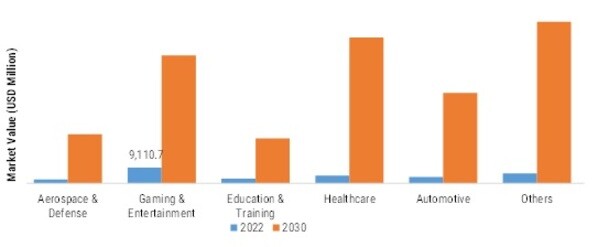AR/VR Hardware Type Insights
Based on Hardware Type, the AR/VR Hardware Market is segmented into Sensors, Processors, Controllers, Cameras, Headphones, Display Monitors, and Others. The sensor segment captured the biggest market share by solution in 2022 and is likely to maintain its dominance in the future years. Sensors are extensively used in the augmented reality and virtual reality hardware market, the sensors support the AR/VR system and are majorly focused on audio and video interface, motion tracking, and voice recognition. Modern-day AR/VR headsets rely on one or more types of sensors utilizing vertical-cavity surface structured-light sensors and a Lidar detection system for depth sensing.
Processors provide AR/VR devices with the instruction and processing power they need to perform the task. For instance, processing the video into AR/VR format while utilizing a combination of GPU processors, display processors, and machine learning.
October 2021 Bosch Sesortec GmbH launched new sensors that have reduced time lag which is very essential during head movements, time lag can be a factor in motion sickness while using AR/VR devices. The company states its new sensors have high stability and low latency enabling the sensors to be used in a wide range of applications including VR gaming.
March 2018 Bosch Sensortec GmbH launched BM1085 motion sensor chips for AR/VR application, navigation, body motion, tracking, and gaming. The sensor is filled with features, combining a low-drift gyroscope with a low-noise accelerometer to significantly reduce the unpleasant motion sickness effect.
AR/VR HARDWARE MARKET SIZE (USD MILLION) by hardware type (2018-2030)
Source: Secondary Research, Primary Research, Market Research Future Database, and Analyst Review
AR/VR Hardware Enterprise Size Insights
Based on Application, the AR/VR Hardware Market is segmented into Head Mounted Display, Head Up Display, and Handheld Devices. The Head Mounted Display segment captured the biggest market share by solution in 2021 and is likely to maintain its dominance in the future years.
Head-mounted displays are display headsets that are worn on the head, head-mounted displays are equipped with display optics that are placed exactly in front of each eye, these head-mounted displays are combined with inertial measurement units, enabling users to see projected scenes. Head-mounted displays are used in a wide range of applications including aviation, engineering, medicine, and gaming.
AR/VR Hardware Industry Vertical Insights
Based on Industry Vertical, the AR/VR Hardware Market is segmented into Aerospace & Defense, Gaming & Entertainment, Education & Training, Healthcare, Automotive, and Others. The Gaming & Entertainment segment captured the biggest market share by solution in 2021 and is likely to maintain its dominance in the future years.
There is a rapid rise in the adoption of augmented and virtual reality in the gaming and entertainment industry, augmented and virtual reality allows the users to experience digital games and movies in a real-world environment. With the rapid advancement in AR/VR technology, the demand is increasing in this vertical.
Virtual reality gaming combines augmented reality gaming and virtual reality gaming. Augmented reality gaming is a combination of audio and visual content in real-time. Virtual reality gaming is a 3D application for creating virtual artificial environment in computer games. AR games are mostly played on smartphones, tablets, and portable gaming systems. Augmented reality gaming uses the existing environment and generates a gaming field within itself. VR gaming control may involve keyboard and mouse, game controllers or motion capture methods. Mixed reality games are mostly played on head-mounted displays.
Acer’s mixed reality headset, Microsoft HoloLens, Samsung Odyssey, Lenovo Explorer, and Dell Visor are some examples of devices on which users can play reality video games.
AR/VR HARDWARE MARKET SIZE (USD MILLION) by industry vertical (2018-2030)
Source: Secondary Research, Primary Research, Market Research Future Database, and Analyst Review













Leave a Comment